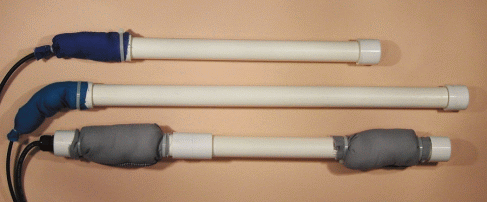Reduced diameter underground reference electrode
Reduced diameter underground reference electrodes were developed to simplify the installation of permanent underground electrodes in congested locations. They can be installed in a 5 cm (2 inch) diameter bore hole which makes them ideal for retrofit installations beneath paved surfaces. These electrodes are frequently used beneath aboveground storage tanks and between closely spaced underground storage tanks. Since these electrodes weigh about one fifth as much as standard bagged electrodes, they are favored when product shipping costs are an important consideration.

The internal construction and life extension features on reduced diameter reference electrodes are similar to those used for our bagged electrodes with similar design lives. Rather than packaging the entire electrode in a cotton bag filled with bentonite-gypsum backfill, a smaller bag containing this backfill is fitted over the membrane. Since the entire surface of this flexible bag is the earth contact area, this design has lower contact resistance to ground.
Reduced diameter electrodes are easily installed at new construction sites where there is an open excavation or in a small diameter bore hole for retrofitting. After the electrode has been placed in the hole, it is covered with about 5 cm (2 inches) screened local backfill and then saturated with about 8 liters (2 gallons) potable water to activate it. Improved performance can be obtained by adding about 20 percent bentonite to the screened backfill. The potential of the electrode should be checked against a portable electrode of known accuracy before the hole is backfilled.
EDI’s SlimLine™ Reference Electrode (Model US) has a 30 year design life and is considered to be the premium reference electrode for all underground installations in congested areas. We also offer an Extended Life version (Model US50) with a 50 year design life for projects where a longer service life is required. For installation beneath an above ground storage tank, some design engineers prefer using our Dual Element Reference Electrode (Model UD). This model has a 30 year design life Cu/CuSO4 (or Ag/AgCl) element along with an encapsulated zinc element. Reduced diameter reference electrodes can be ordered with an integral rod coupon (Models USI, USI50).
Importance of Backfill
The backfill surrounding a bagged reference electrode is a mix of gypsum and bentonite. The primary purpose of backfill is to retain water which ensures that a low contact resistance between the electrode and the surrounding earth is maintained. Additionally, backfill usually prevents the inner core of the electrode which contains a saturated salt gel from drying out. During severely dry conditions, the electrode may dry out. The backfill will rewet with local groundwater, and the electrode should re-activate. However, local ground water will have many other chemicals dissolved in it that can affect the accuracy of the electrode. If this situation is suspected, the electrode should be calibrated against a reference electrode of known accuracy to determine whether replacement is necessary.
Potential measurements beneath ASTs
The environmental conditions beneath an aboveground storage tank make it very difficult to obtain potential measurements. The sand is dry when the electrode is first installed. Cathodic protection currents and/or heat from the product further dries out the sand sharply increasing resistivity. A permanently installed reference electrode can completely dry out in this environment and the absence of moisture in the area will prevent it from rewetting. Consequently, electrodes in such locations may last only a few years. That may be sufficient time, however, for commissioning and testing a cathodic protection system. Where potential measurements throughout the life of an AST are desired, use our Undertank Reference Electrode (Model UT). Download our paper on Instrumented CP Systems on an AST for additional information on potential measurements beneath an aboveground storage tank.
Design Life
The design life of a reference electrode is an estimate of the time based on test results it would take for enough salt to diffuse out from the inner core to lower the salt concentration to below saturation. At EDI, we use several techniques to extend this time as much as possible. One of these techniques is to increase the amount of salt reserve contained in the gel. This is one reason why longer life electrodes have physically bigger housings. Download our paper Factors Affecting the Accuracy of Reference Electrodes to learn more.
For More Information
Complete Product Information and Installation Instructions are available for downloading as pdf files. Click on the documents you wish to download.
Reduced diameter underground reference electrodes (Data Sheet)
Installation Instructions for products with zinc elements (Model UD).
Installation Instruction for reduced diameter underground reference electrodes.
EDI products may be purchased from any corrosion control products distributor or directly from EDI.
